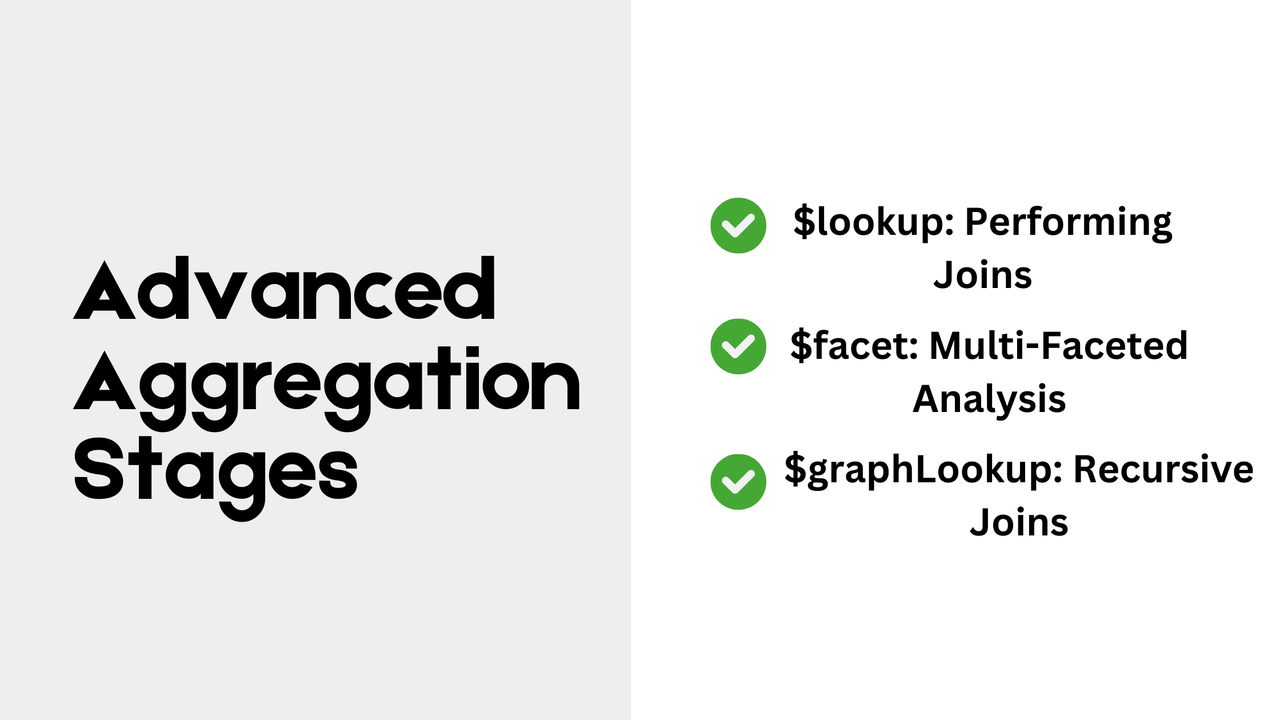
Beyond CRUD: Leveraging MongoDB’s Advanced Aggregation Framework for Complex Analytics
MongoDB’s aggregation framework is a powerful tool for performing complex analytics and data transformations beyond basic CRUD operations. The framework allows for sophisticated data processing, including filtering, grouping, sorting, and joining data. This article delves into advanced features of MongoDB’s aggregation framework, providing practical examples and insights on how to harness its capabilities for complex analytics.
Understanding MongoDB’s Aggregation Framework
The aggregation framework in MongoDB is designed to process and analyze data in a pipeline manner. It enables you to perform operations like filtering, grouping, and reshaping documents. The framework is comprised of a series of stages that transform data sequentially. Key stages include $match, $group, $project, $sort, and more.
An aggregation pipeline is a series of stages that process documents in a collection, transforming them from one form to another. Each stage in the pipeline performs a specific operation, and the output of one stage becomes the input for the next. This pipeline approach allows for flexible and efficient data manipulation.
Key Characteristics
- Sequential Processing : Each stage operates on the results from the previous stage.
- Transformation and Filtering : Stages can filter, sort, group, and reshape data.
- Output : The final output is a set of documents that have been processed according to the stages defined in the pipeline.
Common Stages in an Aggregation Pipeline
Here are some commonly used stages in MongoDB’s aggregation framework:

$match
The $match stage filters documents based on specified criteria. It is similar to a find query but is used within the aggregation pipeline.
Example : Filter documents where the status is "active".
db.orders.aggregate([{ $match: { status: "active" } }]);
$project
The $project stage reshapes documents by including or excluding fields, renaming fields, or creating new fields.
Example : Include only the orderId and total fields.
db.orders.aggregate([{ $project: { _id: 0, orderId: 1, total: 1 } }]);
$group
The $group stage groups documents by a specified field and performs aggregation operations like summing, averaging, or counting.
Example : Calculate the total sales per productId.
db.orders.aggregate([
{ $group: { _id: "$productId", totalSales: { $sum: "$amount" } } },
]);
$sort
The $sort stage orders documents by specified fields.
Example : Sort documents by total in descending order.
db.orders.aggregate([{ $sort: { total: -1 } }]);
$lookup
The $lookup stage performs a left outer join with another collection, allowing you to enrich documents with related data.
Example : Join orders with products to include product details.
db.orders.aggregate([
{
$lookup: {
from: "products",
localField: "productId",
foreignField: "productId",
as: "productDetails",
},
},
]);
$unwind
The $unwind stage deconstructs an array field from the input documents to output a document for each element of the array.
Example : Deconstruct the items array in orders.
db.orders.aggregate([{ $unwind: "$items" }]);
$facet
The $facet stage allows running multiple aggregation pipelines within a single stage, providing a way to perform complex multi-dimensional analysis.
Example : Calculate total sales and average sales in a single query.
db.orders.aggregate([
{
$facet: {
totalSales: [{ $group: { _id: null, total: { $sum: "$amount" } } }],
averageSales: [{ $group: { _id: null, average: { $avg: "$amount" } } }],
},
},
]);
Pipeline Processing Flow
- Document Input : Each stage receives documents from the previous stage or from the collection.
- Stage Execution : Each stage performs its defined operation on the incoming documents.
- Document Output : The output of one stage becomes the input for the next stage.
- Final Result : The final stage outputs the processed documents as the result of the aggregation query.
Example Pipeline :
db.orders.aggregate([
{ $match: { status: "completed" } },
{ $group: { _id: "$customerId", totalSpent: { $sum: "$amount" } } },
{ $sort: { totalSpent: -1 } },
]);
Explanation :
- $match : Filters orders with status "completed".
- $group : Groups by
customerIdand calculates total amount spent. - $sort : Sorts customers by total amount spent in descending order.
Best Practices for Using Aggregation Pipelines
- Use Indexes : Index fields used in $match and $sort stages to optimize performance.
- Minimize Pipeline Complexity : Keep pipelines as simple as possible to reduce processing time.
- Leverage Stages Efficiently : Use stages like $project and $group to minimize the size of documents as early as possible.
- Monitor Performance : Regularly review performance and adjust pipeline stages as needed to handle large datasets efficiently.
Advanced Aggregation Stages

$lookup: Performing Joins
The $lookup stage allows you to perform left outer joins between collections, enabling the aggregation pipeline to combine documents from different collections based on a matching field.
Use Case : Join an orders collection with a products collection to get detailed order information including product details.
Example :
db.orders.aggregate([
{
$lookup: {
from: "products",
localField: "productId",
foreignField: "productId",
as: "productDetails",
},
},
{ $unwind: "$productDetails" },
{
$project: {
_id: 0,
orderId: 1,
quantity: 1,
"productDetails.name": 1,
"productDetails.price": 1,
},
},
]);
This query joins the orders collection with the products collection, creating a new field productDetails in the output.
$facet: Multi-Faceted Analysis
The $facet stage allows you to run multiple aggregation pipelines within a single stage, enabling multi-faceted analysis of data.
Use Case : Analyze sales data by calculating total sales, average sales, and sales by region in a single query.
Example :
db.sales.aggregate([
{
$facet: {
totalSales: [{ $group: { _id: null, total: { $sum: "$amount" } } }],
averageSales: [{ $group: { _id: null, average: { $avg: "$amount" } } }],
salesByRegion: [
{ $group: { _id: "$region", total: { $sum: "$amount" } } },
{ $sort: { total: -1 } },
],
},
},
]);
This query runs three different aggregation pipelines to get total sales, average sales, and sales by region, all in one go.
$graphLookup: Recursive Joins
The $graphLookup stage enables recursive searches within the same collection, allowing you to perform hierarchical data queries, such as traversing organizational structures or bill of materials.
Use Case : Retrieve a hierarchical structure of employees, starting from a specific employee and including all direct and indirect reports.
Example:
db.employees.aggregate([
{
$match: { employeeId: "12345" },
},
{
$graphLookup: {
from: "employees",
startWith: "$employeeId",
connectFromField: "employeeId",
connectToField: "managerId",
as: "subordinates",
},
},
]);
This query starts with a specific employee and recursively retrieves all employees reporting to them directly or indirectly.
Performance Considerations
Indexing for Aggregation Performance
Indexes can significantly improve the performance of aggregation queries, particularly for stages like $match and $sort. Ensure that fields used in $match and $sort are properly indexed.
Example:
db.sales.createIndex({ date: 1 });
Indexing on the date field will speed up aggregation queries that involve filtering or sorting by date.
Managing Large Aggregation Pipelines
For large datasets, managing aggregation performance involves breaking down complex pipelines into simpler stages and using $merge to output intermediate results.
Example:
db.orders.aggregate([
{ $match: { status: "shipped" } },
{ $group: { _id: "$customerId", totalAmount: { $sum: "$amount" } } },
{ $merge: { into: "aggregatedOrders" } },
]);
This pipeline filters and groups data, then merges the result into a new collection aggregatedOrders for further analysis.
Practical Use Cases and Examples
Real-Time Analytics Dashboard
Create a real-time analytics dashboard that tracks user activity and engagement metrics, using aggregation pipelines to calculate active users, user growth, and engagement rates.
Example:
db.userActivity.aggregate([
{ $match: { timestamp: { $gte: ISODate("2024-01-01T00:00:00Z") } } },
{
$group: {
_id: null,
totalActiveUsers: { $sum: 1 },
dailyActiveUsers: {
$push: {
date: { $dateToString: { format: "%Y-%m-%d", date: "$timestamp" } },
count: { $sum: 1 },
},
},
},
},
]);
This query aggregates daily active users and counts total active users since the start of the year.
Customer Segmentation Analysis
Perform customer segmentation analysis to categorize customers based on their purchasing behavior and lifetime value.
Example:
db.customers.aggregate([
{
$group: {
_id: "$segment",
totalSales: { $sum: "$lifetimeValue" },
averagePurchase: { $avg: "$totalPurchases" },
},
},
{ $sort: { totalSales: -1 } },
]);
This query groups customers by their segment and calculates total sales and average purchases, sorted by total sales.
Next.Js FAQ
When performing complex analytics on large datasets using MongoDB’s aggregation framework, the following key performance considerations come into play:
- Indexing: Ensure relevant fields are indexed to speed up $match stages.
- Pipeline Optimization: Place $match, $project, and $limit stages early in the pipeline to reduce the data being processed downstream.
- Memory Usage: For operations that require a large amount of data (like $sort or $group ), use the
allowDiskUseoption to prevent memory limitations. - Sharding: For horizontally scaled systems, ensure your pipelines are optimized for sharding by using shard keys efficiently in the early stages of the pipeline.
MongoDB’s $lookup stage allows for performing left-outer joins between collections, akin to SQL joins. It is particularly useful for:
- Combining documents from two collections based on a matching field.
- Handling one-to-many and many-to-many relationships.
Limitations include:
The $facet stage allows for parallel execution of multiple sub-pipelines within a single aggregation pipeline. This is useful for running multiple analytics queries on the same dataset. For example, you can use $facet to:
- Calculate multiple metrics (e.g., average, total, count) in one query.
- Generate multiple result sets from the same data, such as various filters or breakdowns.
The key advantage is that $facet allows for running multiple complex operations efficiently within a single aggregation, reducing the need for multiple queries and improving performance.
MongoDB’s aggregation framework supports a wide variety of advanced operators that are crucial for performing complex analytics, such as:
- $bucket and $bucketAuto : For bucketing data into ranges, similar to SQL’s
GROUP BY. - $graphLookup : For recursive traversal of graph-like data structures, ideal for hierarchical or networked datasets.
- $merge : To write the results of an aggregation pipeline directly into a collection, useful for data transformation workflows.
- $group : For complex groupings and aggregations, such as sum, average, min, max, and other custom accumulations.
These operators allow MongoDB to perform tasks beyond simple data retrieval, enabling it to serve as a powerful analytics engine.
Managing memory efficiently in MongoDB’s aggregation framework is critical for performance when dealing with large datasets:
- Use the
allowDiskUseoption to enable disk-based sorting and aggregation when the in-memory limits are reached. - Break down large pipelines into smaller steps, writing intermediate results to temporary collections to avoid memory overconsumption.
- Optimize your pipeline to use stages like $match, $limit, and $project early to filter and reduce the dataset size before performing memory-intensive operations like $group or $sort.
Conclusion
MongoDB’s advanced aggregation framework provides powerful tools for performing complex analytics and data transformations. By leveraging stages like $lookup, $facet, $graphLookup, and optimizing performance with indexing and pipeline management, you can build sophisticated data processing workflows. These capabilities extend MongoDB’s usefulness beyond simple CRUD operations, enabling rich, real-time analytics and insightful data exploration for modern applications.





